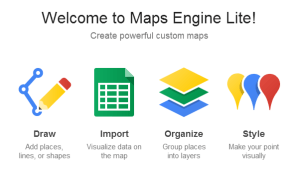- 2 replies
- 2,313 views
- Add Reply
- 5 replies
- 1,902 views
- Add Reply
- 2 replies
- 2,431 views
- Add Reply
- 3 replies
- 3,484 views
- Add Reply
- 4 replies
- 1,685 views
- Add Reply
Google Launches Maps Engine Lite (BETA)

By Lurker,


For years now, Google has offered its Google Maps Engine to enterprises that want to visualize their custom geospacial data. Starting today, anybody will be able to use a subset of this functionality, thanks to the launch of Google Maps Engine Lite (beta). This new tool, Google says, will allow any mapping enthusiast to “create and share robust custom maps using this powerful, easy-to-use tool.”
Maps Engine Lite allows users to upload small spreadsheets with locations and visualize them on a ma
course online free(Maps and the Geospatial Revolution)Pennsylvania State University

By shaimaa gamal,
Maps and the Geospatial Revolution
Anthony C. Robinson
Learn how advances in geospatial technology and analytical methods have changed how we do everything, and discover how to make maps and analyze geographic patterns using the latest tools.
Jul 17th 2013 (5 weeks long)
About the Course
The past decade has seen an explosion of new mechanisms for understanding and using location information in widely-accessible technologies. This Geospatial Revolution has resulted in the de
What is your opinion about The future of ArcObject
By Amir 2010a,
hi
learning Arc object with C# or Vb.net is very Time consumming
What is your opinion about the future of arc object?
is it nessssary learning Arc object and in general GIS Programming?
best regard
image fusion

By Rose,
Im looking for a person who knows IDL, I have some questions about image fusion based on bayesian in IDL code.
Is there anyone who can help me??
Thanks in advance
email: [email protected]
Connectivity Matrix of Vertices within a Line
By cslraju,
I've been wondering, if there's a way to generate a connectivity matrix for the vertices of multipart polyline. For instance
a_____b____c____f
|
|
|
d
a is connected to b
b is connected to a, c, d
c is connected to b,f
d is connected to b
f is connected to c
If I can get this information, then it'll be helpful for me to build a web-app. Any suggestion?
-
Forum Statistics
8.7k
Total Topics43.4k
Total Posts





